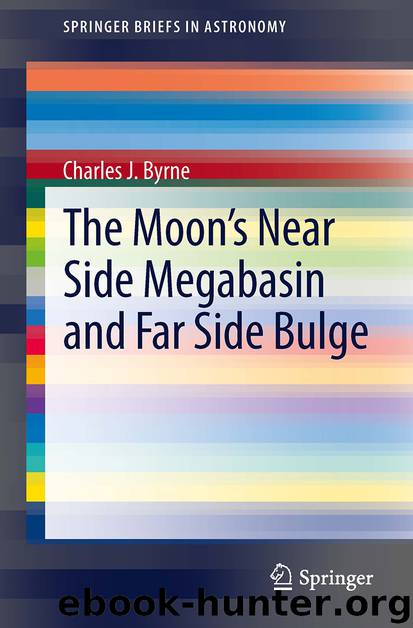The Moon's Near Side Megabasin and Far Side Bulge by Charles Byrne

Author:Charles Byrne
Language: eng
Format: epub
Publisher: Springer New York, New York, NY
6.2.8 Mascons
Mascon is “short” for a mass concentration (Muller and Sjogren 1968). Its effect is to produce a positive anomaly in the gravity field. There are two related definitions, one from the viewpoint of spacecraft navigation and the other from understanding the nature and history of the lunar surface. The navigation definition concerns those mascons that are strong enough to perturb the flight of a spacecraft sufficiently to affect its mission goals. Lunar scientists are interested in the physical implications of a mascon; what is the nature of the concentrated mass? Where does it come from? What does it imply about the surface environment? A mascon can be either a mountain of the same material of its surroundings or a concentration of relatively high density material. In either case, it has not achieved isostatic equilibrium with the underlying mantle; instead, its weight is supported by stress in the crust.
Large lunar mascons in the crater of the NSM (see Fig. 1.6) are associated with the maria in the Imbrium , Serenitatis, Crisium, and Nectaris basins. Most large mascons are in the flat crust of the NSM where basaltic lava is plentiful, but smaller mascons are of considerable scientific interest. The basin itself may have achieved isostatic equilibrium when the crust and mantle were relatively plastic but the maria, deposited much later, is supported by a strong well-hardened crust and therefore acts like a point source of an anomalous free-air gravity field. From a spacecraft view, the closer the orbit is to the surface, the stronger the anomaly. From a science view, the strength of the anomaly can give insight into the difference of density between the mascon material and the crust, the volume of the material, and the bearing strength of the crust.
An estimate of the volume of the dense basaltic lava in a basin may be calculated from the model of a cavity and the level of fill. The resultant volumes for the four largest mascons of Fig. 1.6 have been calculated from the parameters of Table 4.3 and Eq. (6.4). Elevation of the level of fill and the depth to the center of gravity of the fill are also shown in Table 6.1.Table 6.1Mascon volumes
Download
This site does not store any files on its server. We only index and link to content provided by other sites. Please contact the content providers to delete copyright contents if any and email us, we'll remove relevant links or contents immediately.
Tools of Titans by Timothy Ferriss(7815)
Turbulence by E. J. Noyes(7702)
Astrophysics for People in a Hurry by Neil DeGrasse Tyson(5002)
Secrets of Antigravity Propulsion: Tesla, UFOs, and Classified Aerospace Technology by Ph.D. Paul A. Laviolette(4994)
Design of Trajectory Optimization Approach for Space Maneuver Vehicle Skip Entry Problems by Runqi Chai & Al Savvaris & Antonios Tsourdos & Senchun Chai(4843)
Room 212 by Kate Stewart(4739)
Pale Blue Dot by Carl Sagan(4618)
The David Icke Guide to the Global Conspiracy (and how to end it) by David Icke(4381)
A Journey Through Divination and Astronomy by Publishing Pottermore(4250)
Apollo 8 by Jeffrey Kluger(3512)
Goodbye Paradise(3446)
Losing the Nobel Prize by Brian Keating(3425)
COSMOS by Carl Sagan(3348)
The Five People You Meet in Heaven by Mitch Albom(3335)
How to Read Water: Clues and Patterns from Puddles to the Sea (Natural Navigation) by Tristan Gooley(3240)
Brief Answers to the Big Questions by Stephen Hawking(3239)
How to Read Nature by Tristan Gooley(3079)
The Order of Time by Carlo Rovelli(3073)
A Brief History of Time by Stephen Hawking(2819)
